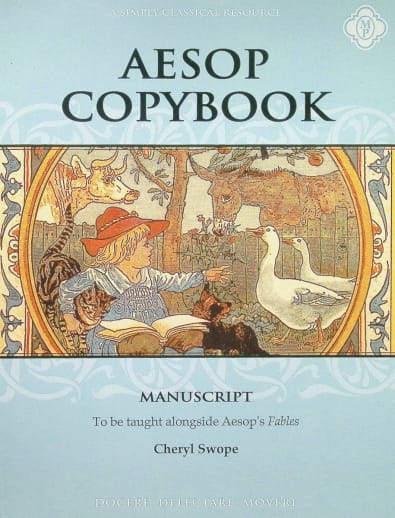Use classic literature to strengthen manuscript writing through the Aesop Copybook from Memoria Press. There are 14 weeks/lessons using different fables. The stories are not included; however, the Aesop's Fables for Children by Milo Winter is recommended for use alongside the copybook. There is a small daily copywork exercise focusing on the fable's moral, detailed for teachers on the first two pages of the guide. By Thursday, your student should be able to copy the moral lesson in good manuscript and describe the story in their own words by using some or all the word prompts in a word bank provided. These are the same exercises that are found in the New American Cursive Aesop Copybook. 35 pgs, paperback. ~Rebecca
Aesop Manuscript Copybook
SKU
039281
ISBN
9781547706204
Grade 4-6
These icons are designed to help you quickly understand and learn important information about our products.
Teaching Method
Traditional
Teacher-centered curriculum commonly used in classrooms that may include a text, teacher manual, tests, etc.
Charlotte Mason
A methodology based on the work of a 19th century educator who maintained that children learn best from literature (Living Books), not textbooks.
Classical
A methodology based on the Latin Trivium (three stages of learning), including the grammar stage (memorization and facts), logic stage (critical thinking), and rhetoric stage (developing/defending ideas).
Unit Study
A thematic or topical approach centered around one topic that integrates multiple subject areas.
Montessori (Discovery)
A methodology based on the work of a 20th century educator that emphasizes student and sensory-driven discovery learning and real-life applications.
Other
Other methodologies
Religious Content
Secular
Contains content contrary to common Christian beliefs (i.e. evolution).
Neutral
Avoids religious or theoretical topics or presents multiple viewpoints without preference.
Christian/Religious
Faith-based or including instructional religious content.
Learning Modality
Auditory
Learns through listening, talking out loud or reading out loud.
Visual
Learns through seeing, prefers written instructions and visual materials.
Kinesthetic/Tactile (Hands-On)
Learns through moving, doing and touching.
Multi-Sensory
Curriculum that employ a variety of activities/components.
Presentation
Sequential
Curriculum progresses through well-defined learning objectives. Emphasizes mastery before moving to the next topic.
Spiral
Topics and concepts are repeated from level to level, adding more depth at each pass and connecting with review.
Conceptual/Topical
Focus is on the “why,” often with a unifying concept as well as specific skills; coverage may be broader.
Teacher Involvement
Low Teacher Involvement
Student-led materials; parent acts as a facilitator.
Medium Teacher Involvement
A mix of teacher-led time and independent student work.
High Teacher Involvement
Teacher-led lessons; may utilize discussions, hands-on activities and working together.
Additional Materials Required
No other materials needed
Everything you need is included.
Other Materials Required
There are additional required resources that are a separate purchase.
Other Materials Optional
There are additional resources mentioned or recommended but are not absolutely necessary.
Consumable
Consumable
Designed to be written in; not reusable.
Non-Consumable
Not designed to be written in; reusable.
Our Price
$10.30 $10.30 $8.85
Rainbow Savings: $1.45
Product Overview
- Classic literature, good morals, and handwriting practice all found in one workbook!
- Suggestions provided for use with advanced students
- Detailed Teacher Notes make using this workbook simple and straightforward from week to week
Description
Publisher's Description of Aesop Manuscript Copybook
Aesop Manuscript Copybook is a lovely companion to Aesop’s Fables for Children that will strengthen your student’s writing and composition skills. Through the moral lessons of Aesop’s Fables, students receive time-honored wisdom, moral instruction, character development, composition skills, reflective thinking, and manuscript practice.
Aesop Manuscript Copybook provides 14 weeks of concise writing practice and composition exercises. The brevity of lessons will assist students to become stronger, more capable thinkers and writers. Teaching instructions are included.
Aesop Manuscript Copybook provides 14 weeks of concise writing practice and composition exercises. The brevity of lessons will assist students to become stronger, more capable thinkers and writers. Teaching instructions are included.
Details
| Product Format: | Paperback |
|---|---|
| Grades: | 4-6 |
| Brand: | Memoria Press |
| ISBN: | 9781547706204 |
| Length in Inches: | 11 |
| Width in Inches: | 8.5 |
| Height in Inches: | 0.1875 |
| Weight in Pounds: | 0.3 |
Videos
Reviews

